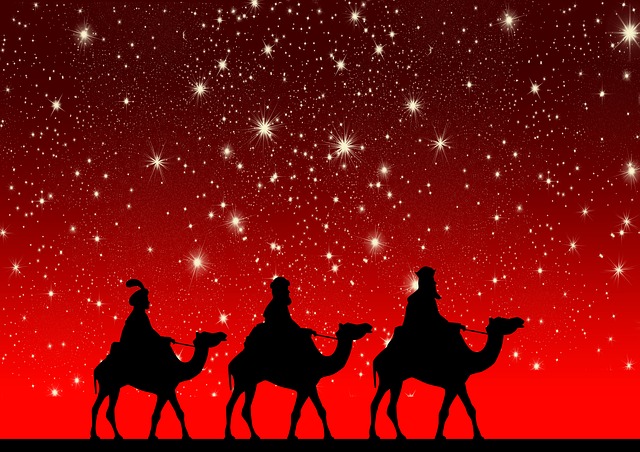Cén t-ainm atá agat ar an 6ú lá d mhí Eanáir? 6 ways to say it in Irish Posted by róislín on Jan 6, 2015 in Irish Language

Na Trí Ríthe ag marcaíocht ar chamaill (http://pixabay.com/en/holy-three-kings-camels-ride-528007/ (License: CC0 Public Domain)
(le Róislín)
How many ways are there to refer to the “last” day of Christmas (January 6th) in Irish?
A solid leathdhosaen, at any rate, maybe a few more in folk tradition. Can you fill in the blanks to complete the phrases? The number of blanks corresponds to the number of letters to be filled in. Freagraí thíos:
- a) Lá Nollag __ __ __ __
- b) E__pea__áin__
- c) an Dara Lá __ __ __ __ den Nollaig
- d) Nollaig na m__an
- e) Féile na __ __ __ __ Ríthe
- f) __ __ __ __ __ __ __ Stéille
The answers are below, with a little background and some pronunciation tips.
By the way, in case you’re wondering, I said “last” in the description above because while January 6th is the “last day” of Christmas in the western Christian religions, it is Christmas Eve for the eastern Orthodox religions. Maybe sometime I’ll look more into the Orthodox terminology in Irish, for example, can there be a concept of “Dhá Lá Dhéag na Nollag” if Christmas itself is on January 7th? And what other holidays are similarly affected by the switch from “Féilire Iúil” to “Féilire Ghreagóra“? An Cháisc, for one, but I recall a few others in the folk tradition as well. And when was that change anyway? Á, feicim anois, a bhuí leis an Vicipéid, 1582, an tús de, ar a laghad, ach, mh’anam, tá a lán dátaí i gceist, i dtíortha éagsúla agus d’úsáidí difriúla. Bhuel, ábhar blag eile, b’fhéidir.
Hope this at least provided some food for thought, a linguistic complement to the bianna speisialta that I hope you had a chance to enjoy over the holiday season: arán sinséir, fíoracha sinséir, cánaí candaí, brioscaí, maróg Nollag, císte torthaí, seacláidí strufail (or “strufail seacláide,” I suppose), bleathach uibhe (remember, “bleathach,” not “bláthach”) agus b’fhéidir gé rósta nó turcaí rósta. SGF – Róislín
Freagraí:
- Lá Nollag Beag, lit. Day of Little Christmas. This phrase can also refer to New Year’s Day, so I actually avoid using it. Seems ambiguous.
- Eipeafáine, Epiphany, based on the Greek for “manifest” (revealing)
- an Dara Lá Déag den Nollaig, the Twelfth Day of (the) Christmas; remember, the holiday is “An Nollaig” in Irish (“The” Christmas)
- Nollaig na mBan [… nuh mahn, remember the “b” of “mBan” is silent, but it is the “hook” that reminds us that this word is one of the forms of the word “bean” (woman)], lit. “Women’s Christmas,” traditionally the day that women go out and enjoy themselves and men look after the house. Hopefully, these days, “na mná” get more than one day out and “na fir” do more around the house anyway! Quick review for the uninitiated: an bhean, the woman; na mná, the woman — despite the fact that the two words look, on the surface, like they’d be completely unrelated. The phrase “Nollaig na mBan” is probably the most popular term for January 6th in everyday usage, “Epiphany” being mostly for theological contexts.
- Féile na dTrí Ríthe [… nuh drzhee REE-huh], the Feast/Festival of the Three Kings; note the eclipsis of the number “trí” (becomes “dtrí) and that this special phrase doesn’t use the usual “personal number” for counting people, which would be “triúr” as in “triúr ban” (three women) or “triúr mac” (three sons).
- Nollaig Stéille [… SHTAYL-yuh], lit. “Christmas of (the) Star.” While the usual Irish word for “star” is “réalta,” there is also the more literary word “stéill,” a direct cognate of “stella.” I haven’t really encountered this phrase much in daily life, but the imagery is beautiful.
Gluais:
a bhuí le, thanks to (nothing to do with “buí,” the color “yellow”)
bláthach [blawkh], buttermilk
bleathach [blækh, with the “æ” sound like English “cat” or Irish “deas“]: if you turn straight to the dictionary for this, the first definition you’ll probably find is “grist” or “a bag or grist,” followed by “oatcakes” (hmm, defined in the plural, a special collective noun for “oatcakes?” whereas “tea cake,” for example, has a clear singular and plural: borróg tae (singular) and borróga tae (plural). Why? Níl a fhios agam! Anyway, the word “bleathach” has long intrigued me. Presumably it’s related to “bleith” (grinding of corn) and “bleitheach” (grain sent to the mill for grinding) but I still wonder how this relates to “eggnog.” Eolas ag duine ar bith agaibh? Was grain of some sort ever added to the egg-based drink, for texture, maybe? Perhaps vaguely evocative of “toast” being crumbled into wine before it was drunk, thus giving us phrases like “to toast the bride and groom.” Or, on a completely different tack, is the word “bleathach” somehow related to “bleacht” (milk, or the cows themselves, both of which have more basic words in Irish, “bainne,” for milk, and “ba,” for cows). Well, enough pondering for this year, maybe revisit this topic an bhliain seo chugainn.
bleathach uibhe [blækh IV-uh], eggnog or egg-flip
féilire, calendar
fíoracha, shapes, figures
maróg, pudding
strufal, truffle

Build vocabulary, practice pronunciation, and more with Transparent Language Online. Available anytime, anywhere, on any device.




Leave a comment: